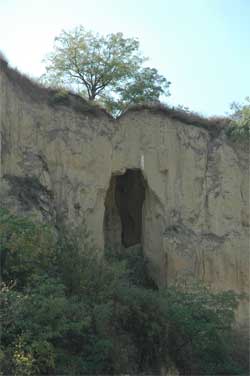LOESSFEST'09 | Aug. 31st – Sept. 3rd, 2009 |Novi Sad-Serbia
Morphometric Investigation of the Loess Sinkhole in Surduk (Vojvodina, Serbia)
Lukić, T.1, Marković, S.B.1, Milojković, N.1, Basarin, B.1, Vasiljević, Dj.1,
Obreht, I.1
1Chair of Physical Geography, Department of Geography, Tourism and Hotel Management, Faculty of Sciences, University of Novi Sad, Serbia
Loess sinkholes are not rare landform features in loess regions. Loess sinkhole in the village of Surduk represents an equivalent of crepuscular caves, a cave type formed in classical karst terrains introduced by Serbian geomorphologist Jovan Cvijić.
 Investigated sinkhole is exposed at loess cliff. This loess landform has a total
height of 12.10 m, and greatest wideness of 3.40 m, i.e, greatest longitude of the
sinkhole is 3.70 m. The height of the entrance on loess cliff is significantly smaller
(8.15 m), and its greatest wideness is 3.10 m. In the center of the crepuscular cavelike
loess landform ceiling there is a “cave window” whose longest axis is 4.15 m
and in its narrowest part wideness is 1 m.
Investigated sinkhole is exposed at loess cliff. This loess landform has a total
height of 12.10 m, and greatest wideness of 3.40 m, i.e, greatest longitude of the
sinkhole is 3.70 m. The height of the entrance on loess cliff is significantly smaller
(8.15 m), and its greatest wideness is 3.10 m. In the center of the crepuscular cavelike
loess landform ceiling there is a “cave window” whose longest axis is 4.15 m
and in its narrowest part wideness is 1 m.
Sinkhole has its biggest longitude in the last glacial loess V-L1. In contact with
paleosol V-S1 a small platform was formed as a consequence of larger resistance
to erosion of clayish material in the base. Erosional processes, initiated by pluvial
erosion, formed a canal that is spreading from clayish material of the paleosol
V-S1 to coluvial material piled in the bottom of the cliff. Sinkohole ceiling is exposed
to erosional processes and that led to “cave window” formation similar to
those in classical karstic terrains.
During intensive fieldwork research of the loess plateaus in Vojvodina province
from 1997, only three sites with similar loess landforms were spotted: at Titel
old brickyard, on the Potoranj site between Banoštor and Čerević villages and investigated
site in Surduk village. Loess sinhkole at Titel old brickyard is very similar
to that in Surduk. Both are formed on steep loess cliffs spreading to the contact
between powerful last glacial loess layer V-L1 and paleosol V-S1. Because of a
higher amount of clay, paleosol V-S1 is significally more resistant to erosion than
porous loess layer. “Cave window” is completely exposed to erosional processes.
However, the nature of erosional processes and its expressively dynamic characteristics and the fact that these landforms are formed in loess sediments, indicates very limited lifetime of these kind of pseudokarstic microrelief forms. Also, dynamics of erosional processes and features of loess sediments initiate potential formation of new interesting landforms on steep loess cliffs. Despite small number of national and international references that are investigating these kind of loess landforms, this study represents humble contribution to these interesting and attractive loess microrelief forms.



